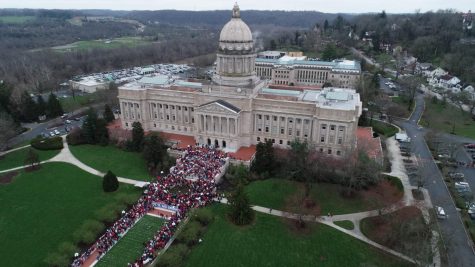Teachers in Okla. & Ky. walking out over salary and funding – How does N.C. compare?
(Charles Bertram/Lexington Herald-Leader/TNS)
Thousands of Kentucky school teachers marched Monday, April 2, 2018 from the Kentucky Education Association’s headquarters to the State Capitol in Frankfort, Ky. to protest legislative changes to their pensions and education cuts. Public schools in all 120 Kentucky counties were closed Monday, either to join in the protest or because of spring break.
In Oklahoma and Kentucky, public school teachers are walking off the job following similar actions last month from West Virginia school teachers.
On Tuesday, the second day of the walkout, Oklahoma teachers stormed the State Capitol, demanding a $10,000 raise in pay as well as a $5,000 raise for support staff.
Additionally, they demanded $200 million over three years in funding for local schools and $500 million in funding for state agencies and other public employees.
In Kentucky, many teachers are on spring break, but that did not stop them from swarming their Capitol as well.
They protested education budget cuts and legislative attempts to change their pension plans into hybrid retirement plans, which blend elements from their traditional plan with 401(k) accounts utilized in the private sector.

Thousands of Kentucky teachers rallied at the state Capitol in Frankfort, Ky. on Monday, April 2, 2018.
Other locations across America are launching grass-roots campaigns or planning to perform similar measures.
In Arizona, teacher organizers have begun a grass-roots effort to bring in school representatives from across the state and are attempting to build support in rural areas, according to The New York Times.
They seek a 20 percent raise and an increase in funding. Their end goal is a statewide walkout.
In Oklahoma, protests began immediately after the state’s education budget was due on April 1. Teachers demanded their voices be heard within the new legislation.
When Oklahoma Governor Mary Fallin signed legislation last week increasing teachers’ base salaries by $6,000 and providing $18 million in in operations funding for schools, many claimed that it just was not good enough.
One group, the Oklahoma Education Association (OEA), the state’s largest teachers’ union, demand that the original plan for a $10,000 and additional funding be supported.
The OEA said that additional funding, for instructional materials such as textbooks, could be found through repealing a capital gains tax exemption and allowing ball and dice gambling, which is taxable.
The additional funding is the most sought after goal by the teachers, as the initial $6,000 pay raise was enough to satisfy many of them. For the children they teach to have proper funding each year is the biggest reason behind their walkout.
For years, education cuts have left 20 percent of public schools in Oklahoma on a four-day week schedule and average teacher salaries ranked 49th in the country at $45,276. Some students do not have textbooks.
“Teachers want more,” Fallin told CBS correspondent Omar Villafranca on Tuesday.
“But it’s kind of like having a teenage kid that wants a better car.”
Fallin, a Republican, went on to state that she suspected the teacher walkouts were not fully grass-roots, but rather that Antifa – a far left anti-fascist group – had a role in the movement.
Alberto Morejon, a middle school teacher from Stillwater, Okla. who was participating at the capitol in Oklahoma City, told The Washington Post “yeah, I would say 100 percent no, I don’t even know who they are. What is Antifa?”
Meanwhile in North Carolina, the N.C. Association of Educators (NCAE) is planning an advocacy day on May 16, which coincides with the day that state lawmakers are set to return to session.
NCAE President Mark Jewell said that the advocacy day will focus on teacher pay, textbook funding, classroom resources and “stopping the tax breaks for the wealthy and [corporations] and reinvesting in public schools.”
Average teacher salaries in North Carolina eclipsed $50,000 for the first time ever in early March, according to recently released figures from the North Carolina Department of Public Instruction (NCDPI).
However, North Carolina still ranks towards the bottom end of the spectrum with teacher salaries, but Arizona, Mississippi and Oklahoma all rank lower on average.
The highest paid teachers in America are in New York and Alaska, averaging from $73,000 to $82,110.
Funding for schools in North Carolina from the state totaled at $9.60 billion during the 2017-2018 school year, according to the NCDPI. This funding covered 1,552,638 students enrolled in North Carolina schools during the aforementioned school year.
$3.7 billion was recorded as being spent on teacher pay for 2016-2017, as data for 2017-2018 is not yet available.
Some advocates for pay raise, including the NCAE, want to see this number increase.
$13.7 million was spent on textbooks during the 2016-2017 school year, according to NCDPI, which was roughly 0.16 percent of the entire expenditure amount, about $8.4 billion.
For 2,557 schools across 244 districts, that $12.5 million would be split into approximately $5,384 per school for textbooks.
If split among each of the 1.5 million students?
$8.86 per student for textbooks.
An additional growing concern comes from the chronic and growing gap in public funding between the highest and lowest-wealth counties in the state.
According to the 2018 Local School Finance Study, published by the Public School Forum of North Carolina, the gap in public school funding per student between the ten highest and ten lowest-wealth counties in the state is $2,364.

Thousands of Kentucky teachers rallied at the state capital of Frankfort on Monday, April 2, 2018.
This all comes as North Carolina’s public school system has come under threat of losing funding from the Republican-controlled legislature.
In May 2017, Democratic senators in the state senate attempted to push five different amendments to prioritize funding, but were turned down each time by Republican senators.
Soon after, Republicans grew irritated with the Democrats and convened amongst themselves. They returned with an amendment of their own to the “Appropriations Bill,” which proposed to give $1 million in funding to the opioid crisis across the state, as reported by The News & Observer.
That $1 million however, was proposed to come from slashed education budgets in Democratic districts.
District 3 in rural northeastern North Carolina suffered the hardest, losing $316,646 in funding to two early college high schools. The district was represented by Erica Smith-Ingram, a Democrat.
According to the proposal, the state was also banned from financially supporting a $300,000 science, technology, engineering and math (STEM) program called Eastern North Carolina STEM, which had helped African-American and low-income families in the region.
However, on June 20, the budget cuts were restored.
While the cuts were ultimately reversed, it was not the first time the current legislative majority has pursued cuts to North Carolina’s public school system.
Over the past half-decade, education spending has been slashed and many options for tenure were eliminated until recently, when multi-year contracts were introduced for public school teachers after their first year.
“Yes, teacher pay is definitely too low [in North Carolina] with little room for advancement,” said a teacher from Perquimans County, N.C., speaking anonymously for employment reasons.
“The state government does need to do more in way of offering competitive pay for all teachers as well as providing funds for needed building renovations and basic supplies.”
The next budget is expected to be passed in North Carolina in 2019.
Whether or not the next budget will include a pay raise for teachers is yet to be known.












